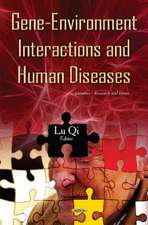The Role of DNA Damage and Repair in Cell Aging: Advances in Cell Aging and Gerontology, cartea 4
Editat de B.A. Gilchrest, V.A. Bohren Limba Engleză Hardback – 8 mar 2001
This book is an excellent single source of information for anyone interested in DNA repair, mechanisms of aging, or certainly their intersection. Students will gain a general appreciation of these fields, but even the most senior investigators will benefit from the detailed coverage of rapidly advancing areas.
Preț: 557.19 lei
Preț vechi: 612.30 lei
-9% Nou
Puncte Express: 836
Preț estimativ în valută:
106.62€ • 111.60$ • 88.74£
106.62€ • 111.60$ • 88.74£
Carte tipărită la comandă
Livrare economică 24 martie-07 aprilie
Preluare comenzi: 021 569.72.76
Specificații
ISBN-13: 9780444504944
ISBN-10: 044450494X
Pagini: 268
Dimensiuni: 152 x 229 x 16 mm
Greutate: 0.53 kg
Ediția:New.
Editura: ELSEVIER SCIENCE
Seria Advances in Cell Aging and Gerontology
ISBN-10: 044450494X
Pagini: 268
Dimensiuni: 152 x 229 x 16 mm
Greutate: 0.53 kg
Ediția:New.
Editura: ELSEVIER SCIENCE
Seria Advances in Cell Aging and Gerontology
Cuprins
Introduction. Aging in mitotic and post-mitotic cells (J. Campisi, H.R. Warner). Age-associated changes in DNA repair and mutation rates (L. Grossman, S.-I. Moriwaki, S. Ray, R.E. Tarone, Qingyi Wei, K.H. Kraemer). Relationship of DNA repair capacity to species lifespan (R.W. Hart, A. Turturro, S.Y. Li). DNA base modifications in aging (J.W. Gaubatz). Models for studying genomic instability during aging (J. Vijg, H. Giese, M.E.T. Dollé). Effects of aging on gene specific repair (A. Richardson, ZhongMao Guo). Poly (ADP-RIBOSE) Polymerase and aging (D.S. Rosenthal, C.M. Simbulan-Rosenthal, Wen Fang Liu, M.E. Smulson). DNA instability, telomere dynamics, and cell transformation (R.J. Shmookler Reis, M.A. Shammas). Commitment signalling for apoptosis, or DNA repair and its relevance to aging and age-dependent diseases (E. Wang, R. Marcotte, H.T. Papaconstantinou, J. Papaconstantinou). DNA damage and its processing with aging: human premature aging syndromes as model systems (V.A. Bohr). Gene action at the Werner helicase locus: its role in the pathobiology of aging (J. Oshima, G.M. Martin, M.D. Gray, M. Poot, P.S. Rabinovitch). Inducible photoprotection in skin: evidence for a eukaryotic SOS response (M.S. Eller, B.A. Gilchrest). List of Contributors.
Recenzii
G. Barja
"This is a valuable book for specialists as well for those entering the field of DNA repair, who need a comprehensive understanding of its relationship to aging." --Aging Clinical and Experimental Research
S.I.S. Rattan
"each chapter is well written and is highly informative." --Biogerontology
C.R. Malz
"makes an important contribution to aging occurring at the level of individual cells and is useful for scientists trying desperately to keep-up with the larger field of research from which their own specializations derive." --Journal of Chemical Neuroanatomy
"This is a valuable book for specialists as well for those entering the field of DNA repair, who need a comprehensive understanding of its relationship to aging." --Aging Clinical and Experimental Research
S.I.S. Rattan
"each chapter is well written and is highly informative." --Biogerontology
C.R. Malz
"makes an important contribution to aging occurring at the level of individual cells and is useful for scientists trying desperately to keep-up with the larger field of research from which their own specializations derive." --Journal of Chemical Neuroanatomy




















